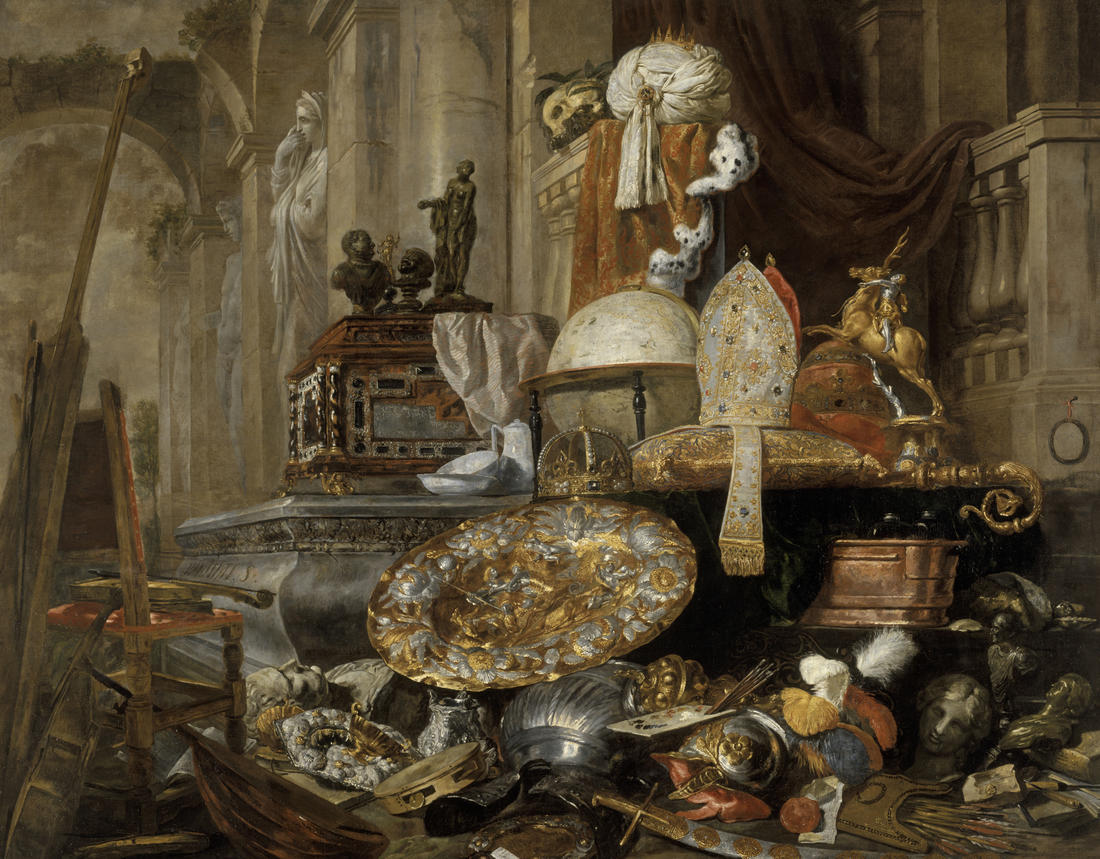The purpose of this still life is to present to the viewer all the possible attributes of wealth and earthly pleasures. The pleasure of music, first of all, to the left, with a group of five instruments. The pleasure of learning, with this world map and these books, placed on the floor to the right of the composition. The pleasure of art, with this sublime tray of gold jewellery and painting instruments: the palette and the brush.
At the top of this pile, a crown can also be seen, along with a turban placed on an ermine coat, a bishop's mitre and a papal tiara. All these act as symbols of the power of kings and religion on earth.
Two details, however, warn viewers against the temptation to let themselves be seduced by these beautiful things. The first is found atop the pyramid formed by the objects. Here, we find a skull. With its hollow eyes, it seems to observe these signs of wealth. It reminds us that death is always triumphant, and that no matter how prosperous our lives and occupation on earth may have been, before death, we are all equal.
In the background, a stone sarcophagus bears the inscription Vanitati S., or "the sacrifice of Vanity". And herein lies the work's message: no matter your riches, you must free yourself of the futility and the vanity of material goods, lest you find yourself in a sarcophagus!
Detail 1: The gigantic instrument placed against the chair is a tromba marina. This instrument has a single chord, on which a bow is pulled and pushed. Very popular in the 17th century, it was used for baroque operas.
Detail 2: The dish in the centre of the painting shows the unhappy love affairs of the goddess Venus. She sees her lover Adonis set off on a boar hunt, from which he will not return alive.

The purpose of this still life is to present to the viewer all the possible attributes of wealth and earthly pleasures. The pleasure of music, first of all, to the left, with a group of five instruments. The pleasure of learning, with this world map and these books, placed on the floor to the right of the composition. The pleasure of art, with this sublime tray of gold jewellery and painting instruments: the palette and the brush.
At the top of this pile, a crown can also be seen, along with a turban placed on an ermine coat, a bishop's mitre and a papal tiara. All these act as symbols of the power of kings and religion on earth.
Two details, however, warn viewers against the temptation to let themselves be seduced by these beautiful things. The first is found atop the pyramid formed by the objects. Here, we find a skull. With its hollow eyes, it seems to observe these signs of wealth. It reminds us that death is always triumphant, and that no matter how prosperous our lives and occupation on earth may have been, before death, we are all equal.
In the background, a stone sarcophagus bears the inscription Vanitati S., or "the sacrifice of Vanity". And herein lies the work's message: no matter your riches, you must free yourself of the futility and the vanity of material goods, lest you find yourself in a sarcophagus!
Detail 1: The gigantic instrument placed against the chair is a tromba marina. This instrument has a single chord, on which a bow is pulled and pushed. Very popular in the 17th century, it was used for baroque operas.
Detail 2: The dish in the centre of the painting shows the unhappy love affairs of the goddess Venus. She sees her lover Adonis set off on a boar hunt, from which he will not return alive.